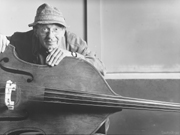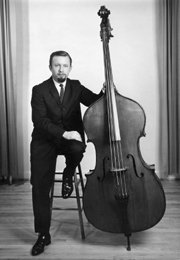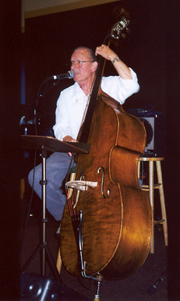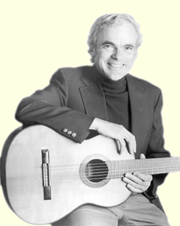|
|||||||||
Carrying the TorchAt 73, jazz musician Joe Byrd maintains his brother Charlie’s legacy — and his ownby Paula Anne Delve Phillips
Musician Joe Byrd has two great loves. Both are shaped like a woman. One is his upbeat, strong and effervescent wife, Elana: a sharp lawyer, a savvy businesswoman and a concert hostess, who deserves the title of Maryland’s First Lady of Jazz. The second is a beautiful stand-up bass built by George Gemunder in 1875. The bass has been by Joe Byrd’s side since his early 20s, left at home only when his career took him to foreign lands playing bass with his older brother, legendary guitarist Charlie Byrd. The Gemunder was recently restored. Like its eminent owner, it now sounds better than ever. Earning His GemunderJoe Byrd was half a century younger when he first picked up the bass. After a year of college, he was drafted into the army from 1953 to 1955. When he came back from the army, he started swingin’ and hasn’t stopped since. “I had played the guitar since I was 10 years old,” Joe said. Then Charlie came down from New York to study in D.C. The older brother recommended that the younger pick up the bass, as there was already one guitarist in the family. “I studied bass for a year in D.C. with Joe Wiles and then auditioned at the Peabody,” Joe Byrd recalls. “They said they’d take me on.” For the serious pursuit of a musical education, the young bassist would need a good instrument. The Gemunder had been used by a Baltimore Symphony bassist throughout his career. The musician’s widow sold the bass to a promising young Peabody Preparatory School student at the behest of his teacher. That young student musician was Joe Byrd. While younger brother Joe was studying music, Charlie Byrd was making a name for himself. “I played with him some prior to going with him full time,” remembers Joe. One of Charlie’s main bass players before Joe was Keter Betts. Betts left to accept an offer from Ella Fitzgerald. Those were the big shoes that Joe Byrd had to fill. Apparently, it was a good fit. Joe and Charlie played together for decades. The Byrd name became legendary all over the world. The Byrds were involved in just about every jazz venue in these parts, on both sides of the Chesapeake Bay Bridge. Joe and Charlie toured the world together, anchored by a strong following in Annapolis, where the King of France Tavern became their home port.
On the Road“That was a real blessing. It really was,” says Joe of his years on the road. The road was different in those days. For one thing, airlines allowed musicians to bring their instruments onto the planes with them. Joe’s traveling bass would be strapped in to the seat beside him, at no extra charge. Nowadays, musicians typically travel apart from their instruments, and many must rent instruments at their destinations. Other things have changed, too. In days gone by, Joe would often have gigs lasting two or three weeks in one location. He recalls a time when musicians could walk around and get to know the place and make friends. That’s very different from the insane travel schedule many are thrown into these days. “In the old days we might fly out to Vancouver and go down the California coast from there,” he says. “That’s when you used to play a club for three weeks and get to know the place. I’d walk every day for several hours, especially in places like San Francisco.” The Second Byrd Partnership“We met in 1973 at the King of France Tavern,” says Joe.
Where else? “We married in 1977,” adds Elana, without missing a beat. By the 1980s, the lure of the road had worn thin. Married well, Byrd wanted to stay and play in the region where he lived. “Joe had toured for probably nine months out of the year,” Elana continues. The first time we really worked together — other than cooking together and making the bed together — is when he didn’t want to travel so much and started the Annapolis Jazz Trio,” she remembers. “It kind of evolved into developing a jazz program,” she explains — as if anyone who wanted to could start a musical empire. “Joe was still playing with Charlie,” recounts Elana. “I think that the first gig that we got was at the old Hilton. It was a six-month contract, six nights a week. Because of the tourists, they wanted to have different music every night, so Joe rotated a large number of people.” He also played L’Enfant Plaza in D.C. and upstairs at Harry Browne’s on the State Circle in Annapolis. Carrying the TorchAfter Charlie’s death in 1999, Byrd says he felt like throwing in the towel. Luckily for jazz lovers, the feeling didn’t last. Byrd brought in new players and honored the bookings that Charlie had already made. That’s when Byrd’s plucky wife Elana increased her role as a producer of events and recordings. That meant cutting back on her career as an attorney specializing in family law and mediation. “I started dropping days at law when Joe decided to stay home and play regionally,” she says.
Now she says she concentrates “on the music side of my life Thursday and Friday and the weekends when we have big events. At least that’s the plan, but there are weeks like this one where I am preparing for a trial and I am doing about 60 hours per week of law and feel as if the music is fulltime as well.” By helping keep Byrd busy, Elana keeps him happy. “The bass is something like being an athlete. You have to do it constantly or you cannot do it,” explains Joe. “Every instrument is challenging, but the bass is a real physical experience.” As the Byrds coped without Charlie, they also lost the place they’d come to call home, when King of France Tavern stopped booking live music. The Byrds found a new home at Loews Annapolis Hotel. Joe’s group opened the Weather Rail and played there for six months. In September 2003, the Byrds left the Maryland Inn for good. (The old jazz room in the King of France Tavern is rumored to be under consideration by Starbucks.) As well as Jazz at the Powerhouse at Loews Hotel, the Byrds also book at 49 West Coffeehouse, Winebar and Gallery in Annapolis. In D.C., they book Blues Alley and the Smithsonian Jazz Cafe. Until recently they were also booking some dates at the MainStay in Rock Hall. Since Charlie’s death, they’ve recorded four CDs, with Elana acting as producer. Two have been marketed. Two are slated for release. Leading the Band
|
Hear for YourselfHear Joe Byrd and various friends at two ongoing series: Joe plays the first and second Wednesday nights of each month and the third Saturday night at 49 West. Those Intimate Jazz presentations feature musicians Joe enjoys playing with. On the fourth weekend, Friday and Saturday night concerts draw multi-generational audiences with the option of dinner with the jazz show. Byrd plays and books throughout Chesapeake Country and beyond. • Wed. June 14 at 49 West: Byrd plays with guest pianist Robert Redd and any other musicians who want to join in. 7-10pm. $10 cover. rsvp: 410-626-9796. • Sat. June 17 at 49 West: Byrd plays Intimate Jazz with guitarist Gene Bertoncini, pictured below. Two shows 8 and 10pm. $20 cover. rsvp: 410-626-9796. • Fri. June 23 at the Loews Powerhouse: Byrd jams during Vintage Jazz Weekend’s Dixie & Ragtime Night. 8pm, Loews Annapolis Hotel, 126 West St., Annapolis. $20 cover. rsvp: 410-269-0777. • Sat. June 24 at the Powerhouse: Byrd plays Vintage Jazz Weekend again. This time it’s the Swing Era with Brooks Tegler’s Combo. 8pm, Loews Annapolis Hotel, 126 West St., Annapolis. $20 cover. rsvp: 410-269-0777. • Wed. July 5 at 49 West: Byrd joins guest pianist Dick Glass. 7-10pm. $10 cover. rsvp: 410-626-9796. • Wed. July 12 at 49 West: Byrd plays with guest pianist Jim Lester and any other musicians who want to join in. 7-10pm. $10 cover. rsvp: 410-626-9796. • Sat. July 15 at 49 West: Byrd plays Intimate Jazz with guitarist Jim Cunningham. Two shows 8 and 10pm. $20 cover. rsvp: 410-626-9796. Call ahead to ensure a spot, but you can try for a walk-in seating. Get more buzz on Joe Byrd online at www.joebyrdjazz.com. |
Paula Phillips is an arts promoter and radio producer as well as a writer. Her last story for Bay Weekly was “Are You Gonna Eat That? New Year’s advice to break the cycle of broken resolutions” [Vol. xiv, No., 1: Jan. 5].
© COPYRIGHT 2004 by New Bay Enterprises, Inc. All rights reserved.








